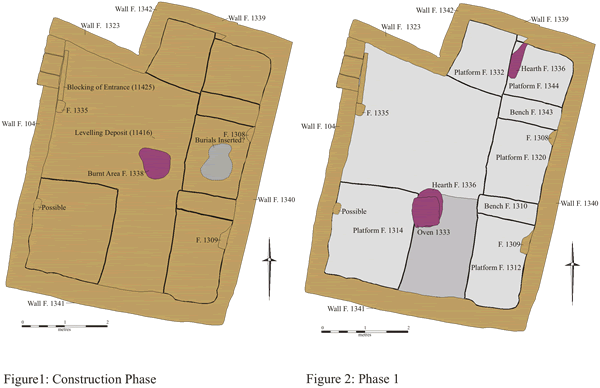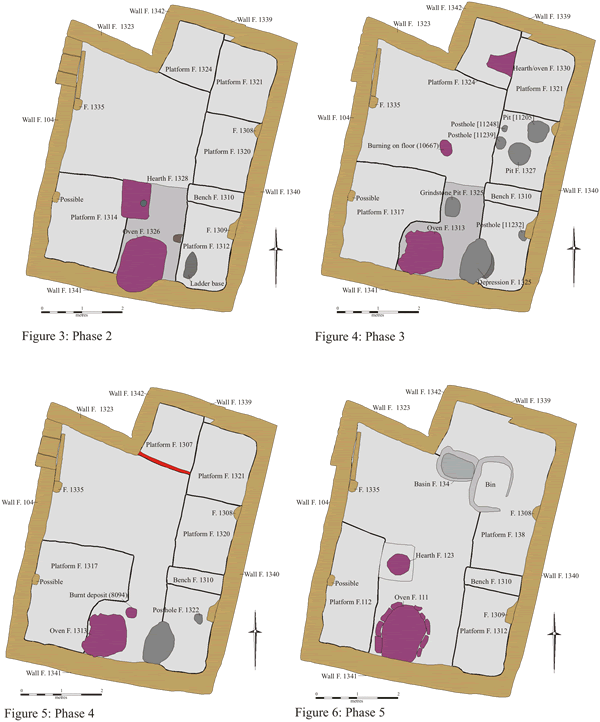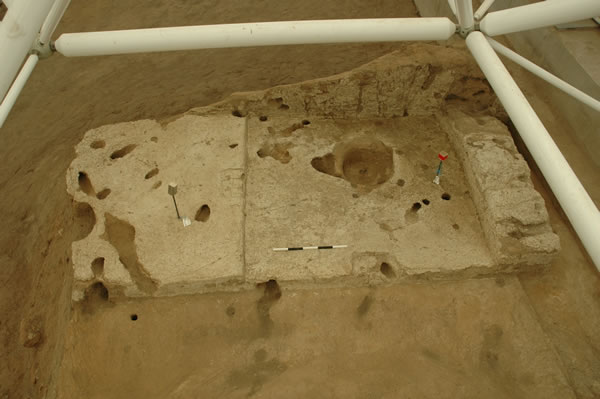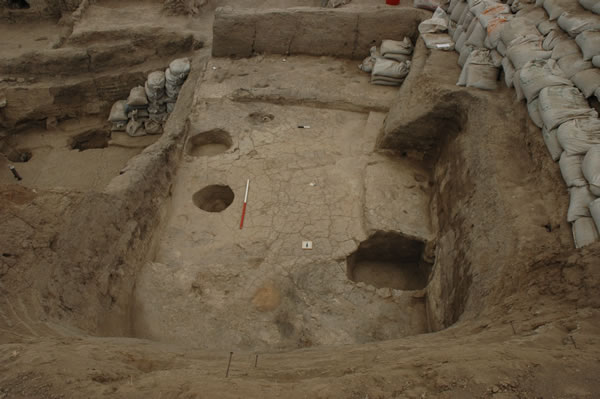EXCAVATION OF THE SOUTH AREA
The four buildings targeted for excavation in the South Area this year covered a range of levels in the Çatalhöyük sequence (see Fig. 6). These buildings are all on-going excavations. Building 44At the highest point to the east Building 44 is tentatively allocated to Levels IV-V. This is an area previously excavated by a team from the University of Thessaloniki between 1997 – 1998 as Building 10. After four years of hoping the Greek team would find funding to return to Çatalhöyük we reopened Building 10 last year. However work this season established that many of the deposits excavated in fact belonged to two buildings. This became apparent when the excavated floors clearly ran under walls that had been considered contemporary. Once two structures had been identified the earlier structure was numbered Building 44 and those features and deposits erroneously allocated were reallocated to their respective structures. The confusion perhaps arose due to the very similar wall alignments of both buildings and perhaps the tendency for floor deposits to be much eroded (by roots and animals) along the interfaces between walls and floors.
Figure 27. Construction phase of Building 44 looking north.
The internal layout of Building 44 consisted a series of platforms and benches laid out along the eastern wall, a platform in the northern bay area of the building and a platform in the southwestern corner. An oven cut into the southern wall of the structure. There were four mud brick constructed pilasters aligned on the inner walls. The central area of the building beyond the oven and platform areas was occupied by a series of ‘clean' plaster/mortar floors. While the excavation of the building is not yet complete, it would seem that this general internal layout was integral from the start. A number of pot emplacements and grindstones were found in concentrations around the oven area but it was perhaps the discovery of what appears to be deliberately placed obsidian pieces in the construction deposit along the northern and southern edges of the eastern platform that generated the most interest. Burials cutting these platforms were defined but not excavated by the end of the season.
Building 42To the centre of the southern side of the South Area, an upstanding ‘island' left from the 1960s, was excavated as Building 42 (see Fig. 6), tentatively attributed to Level V. As far as Mellaart's reports indicate this building was defined as the southern limit of his excavation area but was not excavated. It appears on a plan of 1964 (Mellaart 1964, fig 11), and although structures to the north, east and west were excavated, this area was left.
Figure 29. Plastered platforms and bench along the east wall of Building 42. The central pit cut was where the figurine (see Fig. 2) was found and the burial with the painted plastered skull (see Fig.3 )was to be found under the platform floors in the top left hand corner of the images
Consequently the walls to the north, east and west of Building 42 have eroded and collapsed since the 1960s. This building is therefore only partially represented in our excavations as it continues south beyond the modern shelter for which the foundation trench was excavated (Farid 2002). The excavated features were beautifully laid out and plastered with a wonderful sequence of use and modification. Along the eastern wall from north to south were two plastered platforms and a bench. The platforms had two small cut niches that appeared to have housed some upstanding feature, perhaps small podiums. The southern oven area was mostly excavated in 2002 but some hearth activity was represented. Floor and packing deposits lay in the central area. Two of the season's most notable finds were found in this building. The small limestone figure (see Fig 2) found in redeposited midden material in a grave that cut the southern of the two platforms and the second was the painted plastered skull held in the arms of a complete skeleton that cut the northern platform (see Fig 4).
Building 50, Spaces 112 & 231On the northern side of the South Area, Building 50 of Level VII was excavated. This was a building excavated by Mellaart in 1963 as Shrine E.VII.9 when most of the occupation sequence of the building had been removed to the horizon of the underlying building infill. However, remnants of floor deposits and all cut features were left and were excavated by the current team in 1995-7. The cut features consisted of post-retrieval pits and 11 burials. This year's work involved the excavation of the northern half of this building which had previously lain beyond the limits of our excavation area. The additional area added 4 more burials making a final count of 15 in an area just 4.3m N-S x c.2.9m E-W. Most notable was the burial of a human with a complete lamb, the first occurrence of an animal treated as a human burial found at Çatalhöyük. The plan of the building consisted of a small northern room (Space 231) but the burials were all from the southern larger room (Space 112). In the centre was a complex of 4 burials the earliest of which was an adult male lying on its back with his legs flexed to the chest (Fig. 30). With this individual was a large worked bird bone ulna, possibly a flute (see worked bone report ) across its chest, and a large flint tear-shaped object and a bone point behind the left scapula. Along the upper vertebrae was a gold brown residue and on the lower chest there was a plaster like substance. On the bones and the skull and the bird bone there was a red substance, possibly ochre or cinnabar.
Figure 30. Adult male associated with a lamb burial. A large flint blade was located near the left shoulder and a large bird bone, possibly a musical instrument, lay across the chest Above this skeleton was a brown interface with phytoliths on top of which was the articulated skeleton of a lamb, between 6-12 months of age. It was in an odd position lying on its back with the hind legs extended at an angle, and the front legs extended vertically upwards. It should be stressed that a sheep buried with a human is a unique find both at Çatalhöyük in specific, and in the Near Eastern Neolithic in general, and throws a fascinating new light on human/animal relations in this period. In the same complex a second burial was of a mature female buried with a number of items including three incised boar tusks with perforations (Fig. 31), a number of stone beads in alignment and a group of bone beads. A third burial was found only about 70mm above the previous and its skeleton was only partly found in situ as it was disturbed by the last in this sequence, that of a male adult found with a large bone hook on the left side of the chest and a cluster of 5 flint tools and one antler point on the right side of the chest.
Figure 31. Adult male with a large bone hook on the chest. Five flint tools and an antler point were also found in association with this burial.
Building 43The fourth building we excavated this year was located towards the centre of the South Area. This building was originally excavated in the 1960s by Mellaart as E.VIII.27. Nothing but a plan with the internal configuration of this building exists from the previous excavations (Mellaart 1964). The outline of the building is irregular, with the longer length lying on a north-south axis. It is wider to the north than to the south (Fig. 32). The eastern wall has a ‘dog-leg' break and the general ‘skewed' alignment with neighbouring houses suggests it was built into an ‘open' space after the construction of surrounding buildings. To the north is a bare narrow room on an eastwest alignment formed by a wall with openings at either end to access the larger room to the south. A platform runs almost the entire length of the north wall of the larger room. A second platform is positioned centrally along the west wall and a third platform lies opposite along the east wall. A large circular oven and small hearth are located in the southern sector of the room. Seven posts are shown on plan, 3 in the larger room and 4 associated with the smaller room. Two burials excavated this year were cut through the western platform. One was a neonatal skeleton and the other an infant of less than 10 years old buried with an array of beads ranging in size, material and shape.
Figure 32. Building 43 looking north. The oven and hearths are located to the south (grey area in the foreground), platforms lie along the east and west walls, with two burial cuts to the left. A small narrow room lies to the north
|






